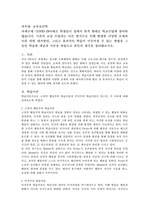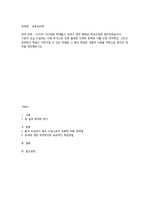

-
미리보기
목차
1. 서론
1) 연구목적
2) 연구방법
2. 본론
1) 지능의 개념 및 이론
2) 창의성의 개념과 이론
3) 지능과 창의성 관계에 대한 설명과 예시
3. 결론
1) 나의 생각
2) 참고문헌본문내용
Ⅰ. 과제주제
창의성과 지능의 관계에 대하여 개념과 이론에 대한 개괄적인 설명과 지능과 창의성의 관계에 대한 설명과 적절한 예시를 수행해야 하는 과제를 부여 받았다.
1.1. 연구목적
창의성과 지능에 대한 개념과 이론에 대한 설명과 관계성을 서술하기 위해 자료를 조사하여 간접인용을 통하여 서술한다.
1.2. 연구방법
인터넷으로 자료를 검색하고 과제주제에 적합한 것들을 추려내어 과제를 수행하며 표절에 주의하도록 하며 마지막 참고문헌이나 자료출저를 쓰도록 한다.
나의 생각도 서술하며 레포트의 구성을 독창적이고 창의성 있게 하며 복사 붙이기는 절대 하지 않도록 한다.
그리고 여러 학문의 관점으로 봤을 때 지능과 창의성 관계를 접목시켜 설명을 해보도록 한다.
본론
Ⅰ. 지능의 개념 및 이론
지능의 개념은 여러 학문적인 관점에 따라서 다르게 해석하고 정의를 할 수 있으며 교육심리학적 관점에서의 지능이론은 전통적 지능이론과 다중적 지능이론들이 있다.
일반적인 지능의 정의
일반적으로 지능을 정의하자면 문제해결 및 인지적 반응을 나타내는 개체의 총체적 능력을 의미한다.
교육심리학적 지능의 정의
교육심리학에서의 지능은 한 개인이 문제에 대해 합리적인 방향이 무엇인지를 생각하고 해결하는 인지적인 능력과 학습 능력을 포함하는 총체적인 능력으로 정의를 한다.
하지만 지능의 개념정의는 여러 학문에 따라 다양하게 관점에 따라서 정의되지만 본래 그자체의 intelligence라는 의미는 다르지 않고 같다. 다시 말해서 본래의 의미인 인간의 지적 능력이라는 의미는 변하지 않으며 기본적인 의미 틀 속에서 학문의 관점에 따라 정의되고 있다.
그리고 지능이라는 것은 2가지의 학문적 관점인 생물학적 관점, 가정학적 관점으로 대표적이게 분류를 할 수 있다.
지능의 이론
지능의 이론학자들은 각 이론들마다 다양한 학자들이 존재하지만 대표적이면서도 내가 선호하는 학자는 Gardner, Sternberg, catell을 예를들어 설명하도록 하겠다.참고자료
· [네이버 지식백과], 지능(심리학 용어사전)
· [네이버 지식백과], 지능(두산백과)
· [네이버 지식백과], 창의성 (교육심리학 용어사전, 2000. 1. 10, 학지사)
· [금성출판사], 티칭백과, 육상이미지
· [중앙일보], (표주연의 직장탐구생활), 탐구이미지
· [사이언스온 한겨레], 음표이미지
· [사이언스온 한겨레], 연재, 창의성 지능 이미지
· [브런치], 뇌이미지, (2050)
· 김춘일 (1999). 창의성 교육, 그 이론과 실제. 교육과학사
· 박찬웅 (1998). 뇌-학습과 기억의 구조. 서울대학교 출판부
· 윤종건 (1994). 창의력의 이론과 실제. 정민사
· 장남기, 임영득, 강호감 (1989). 과학교육심리학. 교육과학사.
· Bouchard, T. J., Jr., & McGue, M.(1981년). Familial studies of intelligence: A review. Science, 212, 1055-1058.
· Ceci, S. J., & Williams, W. M. (1997년). Schooling, intelligence, and income. American Psychologist, 52, 1051-1058.
· Ceci, S. J., &Gilstrap, L. L. (2000년). Determinants of intelligence: Schooling and intelligence. Encyclopedia of Psychology, 2, 496-498.
· Daley, T. C., Whaley, S. E., Sigman, M. D., Espinosa, M. P., & Neuman, C. (2003년). IQ on the rise: The Flynn effect in rural Kenyan children. Psychological Science, 14, 215–219.
· Dodge, K. A., Coie, J. D., & Lynam, D. (2006년). Aggression and antisocial behavior in youth. In W. Damon, R.M. Lerner, & N. Eisenberg (Eds.) Handbook of Child Psychology, Vol. 3 Hoboken, NJ: John Wiley & Sons.
· Flynn, J. R. (1994). IQ gains over time. In R. J. Sternberg (Ed.), The Encyclopedia of Human Intelligence (pp. 617-623). New York: MacMillan.
· Flynn, J. R. (1999년). Searching for justice: The discovery of IQ gains over time. American Psychologist, 54, 5-20.
· Flynn, J. R. (2003년). Movies about intelligence: The limitations of g. Current Directions in Psychological Science, 12(3), 95-99.
· Jensen, A. R. (1998년). The g Factor: The Science of Mental Ability. New York: Praeger.
· Khaleefa, O., Abdelwahid, S. B., Abdulradi, F., & Lynn, R. (2008년). The increase of intelligence in Sudan 1964–2006. Personality and Individual Differences, 45(5), 412-413.
· McCall, R. B. (1977년). Childhood IQs as predictors of adult educational and occupational status. Science, 197, 482-483.
· McGue, M., Bouchard Jr, T. J., Iacono, W. G., & Lykken, D. T. (1993년). Behavioral genetics of cognitive ability: A life-span perspective. In R. Plomin & G. E. McClearn (Eds.), Nature, Nurture, and Psychology. Washington, DC: American Psychological Association.
· Neisser, U., Boodoo, G., Bouchard Jr, T. J., Boykin, A. W., Brody, N., Ceci, S. J., ... & Urbina, S. (1996년). Intelligence: Knowns and unknowns. American Psychologist, 51(2), 77-101.
· Sigman, M., & Whaley, S. E. (1998).The role of nutrition in the development of intelligence. In U. Neisser (Ed.), The Rising Curve: Long-term Gains in IQ and Related Measures (pp. 155-182). Washington, DC: American Psychological Association.
· Sternberg, R. J. (1985년). Beyond IQ: A Triarchic Theory of Human Intelligence. Cambridge: Cambridge University Press.
· Sternberg, R. J. (1997). A triarchic view of giftedness: Theory and practice. In N. Coleangelo & G. A. Davis (Eds.), Handbook of Gifted Education (pp. 43–53). Boston: Allyn and Bacon.태그
-
자료후기
Ai 리뷰이 문서는 지능과 창의성의 개념과 이론을 종합적으로 다루고 있으며, 두 요소의 관계를 구체적으로 설명하고 있습니다. -
자주묻는질문의 답변을 확인해 주세요

꼭 알아주세요
-
자료의 정보 및 내용의 진실성에 대하여 해피캠퍼스는 보증하지 않으며, 해당 정보 및 게시물 저작권과 기타 법적 책임은 자료 등록자에게 있습니다.
자료 및 게시물 내용의 불법적 이용, 무단 전재∙배포는 금지되어 있습니다.
저작권침해, 명예훼손 등 분쟁 요소 발견 시 고객센터의 저작권침해 신고센터를 이용해 주시기 바랍니다. -
해피캠퍼스는 구매자와 판매자 모두가 만족하는 서비스가 되도록 노력하고 있으며, 아래의 4가지 자료환불 조건을 꼭 확인해주시기 바랍니다.
파일오류 중복자료 저작권 없음 설명과 실제 내용 불일치 파일의 다운로드가 제대로 되지 않거나 파일형식에 맞는 프로그램으로 정상 작동하지 않는 경우 다른 자료와 70% 이상 내용이 일치하는 경우 (중복임을 확인할 수 있는 근거 필요함) 인터넷의 다른 사이트, 연구기관, 학교, 서적 등의 자료를 도용한 경우 자료의 설명과 실제 자료의 내용이 일치하지 않는 경우
찾으시던 자료가 아닌가요?
지금 보는 자료와 연관되어 있어요!
문서 초안을 생성해주는 EasyAI


















